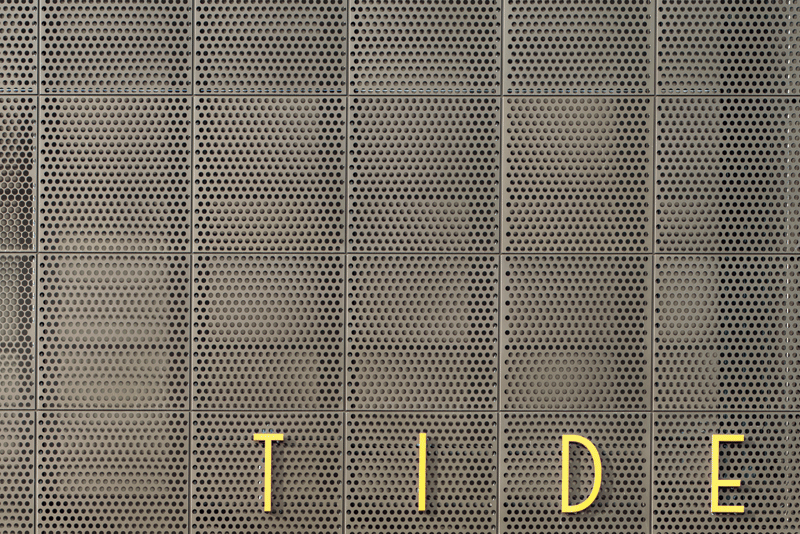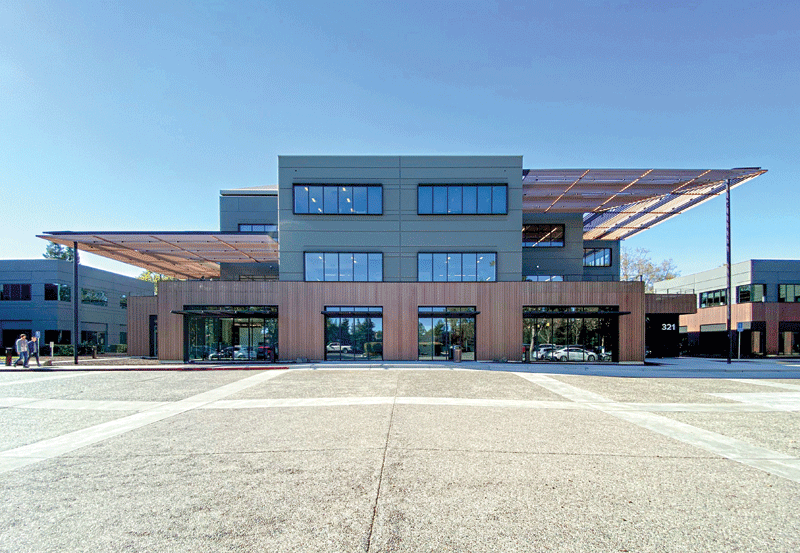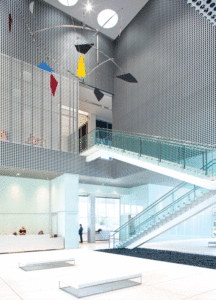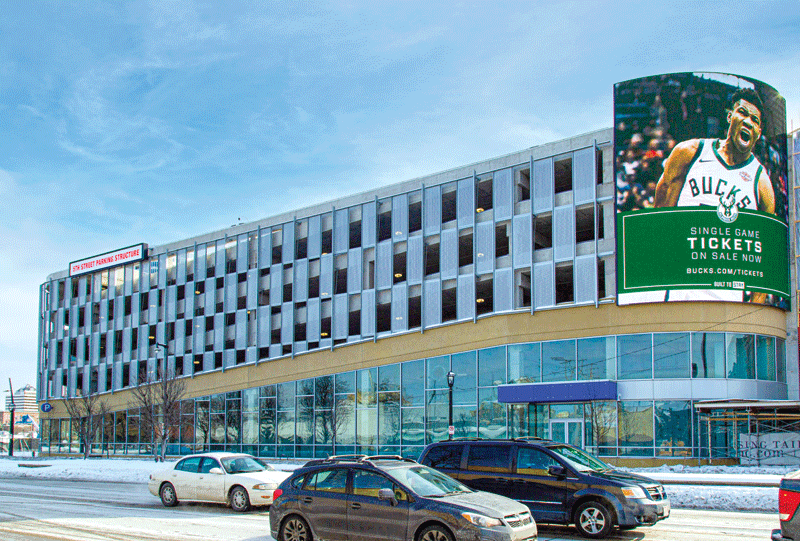
Perforated aluminum wall panels, sunshades, and decorative products can enhance a building’s appearance and functionality. Choosing durable finishes not only complements and accentuates distinctive designs, but also can contribute to the material’s performance, sustainability, and longevity.
The choice is yours
Liquid-based architectural painted coatings are available in a nearly unlimited choice of colors. Some of the largest coating applicators have libraries with more than 55,000 paint colors. If a project requires an exact color match, such as to a customer’s brand, confirm the finisher has in-house custom-matching and blending capabilities. Experienced applicators may offer options including mica and metallic paints that sparkle and shine, or textured finishes that mimic terra cotta and wood grain.
Anodized finishes highlight the natural metallic appearance of the aluminum. The architectural anodized color palette is limited to clear, silver, black, champagne, and bronze tones. Proprietary anodized finishes extend this range to rich copper and Bordeaux hues.
Unlike painted finishes that coat and adhere to the metal surface, anodized finishes are an integral part of the aluminum.
The anodic coating produced is extremely durable. The hardness of its surface is comparable to a sapphire—the second-hardest substance on Earth, next to a diamond. This characteristic makes anodize a finish of choice for use in high-traffic areas where wear-resistant and abrasion-resistant properties are important.
Elevating parking, sparkling finish

Given most Americans arrive at their destinations by car, parking facilities represent an overlooked opportunity to attract and welcome people. Airports, offices, entertainment venues, hospitals, hotels, government centers, high-rise residences, universities, shopping centers, and transit hubs all incorporate parking.
A parking garage offers a safe, secure place to park a vehicle out of the sun, rain, and snow. Wall panels not only conceal an otherwise bare concrete structure but integrate it within the surrounding community. More than a utilitarian structure, this space often conveys the first impression of a property long before reaching the building’s lobby.
Finished architectural aluminum products can dramatically elevate the design of a parking garage to better align with the building owner’s investment. Choosing high-performance finishes adds significant value by helping present the intended appearance and perform as required in high-traffic areas with minimal maintenance.
When fans see the Milwaukee Bucks play basketball at Fiserv Forum, most arrive by way of the attached parking garage. The garage’s storefront aluminum framing matches the arena’s curtain wall using a “sparkly silver” mica coating. Painted finishes that meet the Fenestration and Glazing Industry Alliance’s (FGIA’s) AAMA 2605 exhibit outstanding resistance to humidity, color change, chalk, gloss loss, and chemicals and provide a long-lasting, durable finish for exterior applications.
Coastal reliance, artistic statement

Coastal areas are beautiful locations for commercial and residential buildings. They also pose the greatest challenges in protecting exterior-facing architectural aluminum products from corrosion. Class I anodized finishes are ideally suited for exterior building structures and other products that must withstand continuous outdoor exposure. These anodized finishes are more resistant to salt spray, including in coastal environments, and are more durable in high-traffic areas.
Designed by Stanley Saitowitz, the Tampa Museum of Art serves as an artistic expression and resilient structure. A perforated metal screen finished in clear anodize clads the exterior of the two buildings. During the day, sunlight reflects off the metal surface, and at night, it transforms into an illuminated canvas with colorful, changing light displays.
Carrying the outside architectural style into the interior, the perforated aluminum panels continue as decorative elements inside the buildings. The anodized finish enhances the protective attributes of the panels, reducing maintenance and repair for the frequently visited public areas of the museum, as well as the office and curatorial facilities.
Get the best results
When having perforated aluminum panels finished for architectural applications, remember to:
- Watch the diameter. If the perforation is very small, the finish may cover the open area and negate the intended appearance. In certain applications—such as when panels are used for ventilation, sound mitigation, or shading—a clogged opening can affect the product’s functionality.
- Specify for high performance. The FGIA publishes the industry-leading specification standards for architectural finishes. To ensure the highest performance and greatest longevity, specify 70 percent polyvinylidene fluoride (PVDF) resin-based architectural coating systems to meet AAMA 2605 and Class I anodize finishes to meet AAMA 611.
- Perforate, then finish. Whether perforating, cutting, curving, or otherwise shaping the metal, most finishers recommend material forming to take place before it is finished to ensure optimal coverage, adhesion, and performance. Be aware this sequence may be a warranty requirement.
- Get rid of grease. Remove residual lubricants, grease, and oils before sending the perforated metal material to the finisher. A finisher’s standard pretreatment cleaning may be unable to remove remaining lubricants, which can cause issues with a consistent, quality finish.
- Finish all surfaces. With perforated metal, there are multiple surfaces—the front, the back, the outer edges, and the inner edges of the cut openings. Request 360-degree or two-sided finishing to ensure every surface has the proper coverage.
Supporting sustainability

For projects with sustainable goals, perforated, finished metal products may offer additional advantages. Environmentally responsible liquid paint applicators can use a 100 percent air capture system and safely destroy the volatile organic compounds (VOCs) with a regenerative thermal oxidizer, so there is no adverse environmental impact. Anodized aluminum does not contain VOCs; it is an inert, noncombustible material and poses no health risks.
Further supporting the environmental criteria of a project, finishing partners may offer additional documentation and certification. At least one provider of anodized aluminum has been recognized with a Declare Label as Living Building Challenge (LBC) Red List Free. LBC Red List Free Declare Label products have been approved as a compliance pathway for certain Leadership in Energy and Environmental Design (LEED) criteria.
Vertical and horizontal shading systems can contribute to daylighting and energy efficiency goals. Larger, perforated open areas at eye level can optimize light and views. Panels and other perforated architectural products can be manufactured with recycled metal content and upcycled at the end of their useful life on a building.
Academic achievement, bronze anodize
Among the many accolades of TIDE Academy in Menlo Park, Calif., the visually attractive, sustainable, and resilient indoor-outdoor learning facility earned the American Institute of Architects (AIA) 2023 Architecture Award, the industry’s highest honor for a single project. The structure is elevated to compensate for the expected rise of storm surge levels and achieves a 67 percent reduction in energy use from the industry baseline.
Designed by LPA Inc., TIDE Academy presents a metal exterior facade that blends a contemporary, high-tech aesthetic and purposeful performance at the high school in the heart of Silicon Valley dedicated to technology, innovation, design, and engineering.
All 1,207 m2 (13,000 sf) of the steel structure’s perforated aluminum panels were finished in a medium bronze anodize. The finished aluminum panels closest to the windows shade interior classrooms, while allowing outdoor views. Elsewhere on the building, the panels provide an ornamental screen, in addition to serving as a handrail on exterior stairs.
Office renewal in shining copper

California’s Mountain View Corporate Center is one of the few large-scale office campuses in Silicon Valley where employees can walk or bike to Caltrain and retail amenities. The transit-oriented property is within walking distance of downtown Mountain View’s Caltrain station, the Evelyn VTA light rail station, and Stevens Creek Trail.
Rockwood Capital acquired the Mountain View Corporate Center’s five buildings spanning 24,712 m2 (266,000 sf) on a 6.5-ha (16-acre) property. Originally built in the late 1980s as a corporate campus for a former single tenant, the new owners invested in updating three buildings from concrete exteriors to a modern copper-colored metal panel facade.
The perforated metal canopies above the buildings’ entrances and balconies, and the solid, extruded aluminum exterior wall cladding were finished in copper anodize. Morin Corporation fabricated 2,136 m2 (23,000 sf) of panels, which were installed by Sheet Metal Systems. Unlike real copper, the copper anodized finish on Mountain View does not patina over time, allowing it to maintain its shiny, new appearance.
Along with the high-tech aesthetic, the durable anodize supports the property’s sustainability goals and protects the aluminum, helping reduce maintenance and repair costs over the extended lifespan of these updated buildings.
Tammy Schroeder, LEED Green Associate, is the director of marketing for Apogee Enterprises’ Architectural Framing Systems segment, including Linetec. Linetec is the largest independent architectural metal finishing services provider in the United States. With more than 20 years of experience, Schroeder serves as an industry educator on high-quality, high-performance architectural finishing and services. She enjoys sharing her knowledge with architects, specifiers, contractors, and product manufacturers working in commercial and residential building markets. Schroeder can be reached at tammy.schroeder@apog.com.





